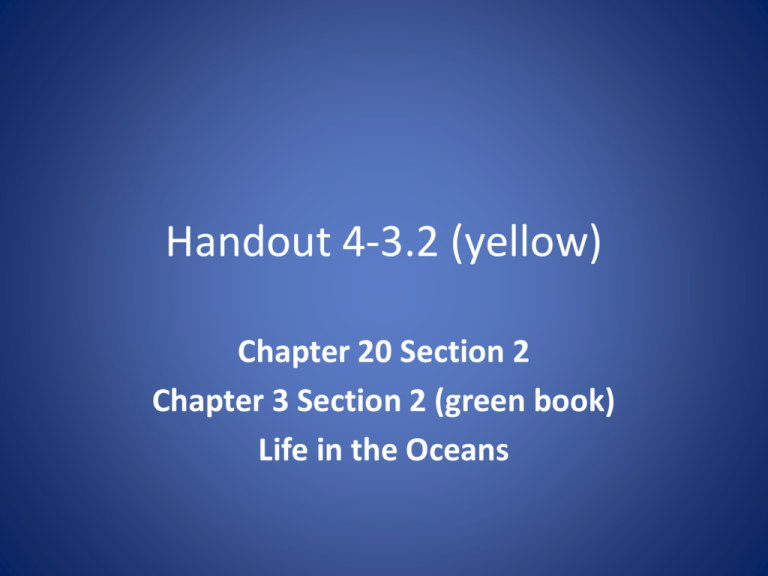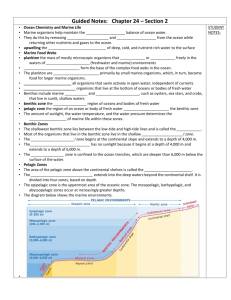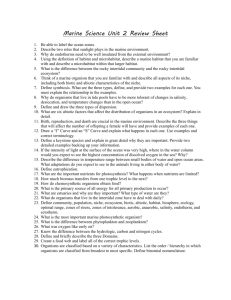Handout 4-3.2 ppt
advertisement

Handout 4-3.2 (yellow) Chapter 20 Section 2 Chapter 3 Section 2 (green book) Life in the Oceans 1 What two major factors do marine organisms depend on for their survival? • a. essential nutrients in ocean water and sunlight 2. Describe the chemistry of the ocean. • A balance of dissolved gases and solids 3. What are three elements absorbed by marine plants? • • • • • • • carbon hydrogen oxygen sulfur nitrogen phosphorus silicon 4. One way that nutrients return to the surface is through a process called upwelling ________. 5. Where are nutrients stored in the ocean? • Deep water 6. What happens when wind blows steadily parallel to a coastline? • Surface water moves farther off shore and the deep, cold water rises to replace it. 7. In what part of the ocean do most marine organisms live? • The upper 100m of water 8. How do plankton form the base of food webs in the ocean? • The plankton are consumed by small marine organisms, which in turn, become food for larger marine animals. • which in turn, become food for larger marine animals. • which in turn, become food for larger marine animals. • which in turn, become food for larger marine animals. • which in turn, become food for larger marine animals. 9. Organisms such as dolphins and squid, that swim actively in open water, are called ________. nekton 10. Organisms that live at the bottom of oceans or bodies of fresh water are called benthos _______. 11. The term for the bottom region of oceans and bodies of fresh water is E. Benthic zone ____________. 12. The term for the region of an ocean or body of fresh water above the benthic A. pelagic zone zone is ____________. 13. This is the shallowest benthic zone, located between the low-tide and high-tide zones. Shifting tides make it a continually changing environment for marine organisms. It is called C. intertidal zone the_______________. 15. The region of the pelagic zone above the continental shelves has abundant sunlight, moderate temperatures, and relatively low water pressure, which are ideal conditions for marine life. Nekton fill the area’s waters and are the source of much of the fish and seafood that humans eat. It is called the D. neritic zone _______________. 16. The zone that extends into the deep waters beyond the continental shelf is divided into four zones based on depth. It is called the B. oceanic zone ______________. Chapter 3 Section 2 (green book) Life in the Oceans 1. Tiny organisms that float near the surface of freshwater and marine plankton environments are called _______. 2. How do plankton get their food? • They use photosynthesis to make their own food. 3. What are three abiotic factors that affect marine ecosystems? • Water temperature • Water depth • Amount of sunlight 4. How does the temperature of ocean water change as it gets deeper? • a. It decreases 5. Which ocean temperature zone has the warmest water? • c. surface zone Matching 6-9 6. warm water and a lot of sunlight; ocean floor stars to lope down a. intertidal zone 7. sea floor drops sharply; contains deep water of the open ocean b. neritic zone 8. ocean floor; deepest parts get no sunlight c. oceanic zone 9. where the ocean meets the land; exposed to air part of the day d. benthic zone 10. Name three kinds of intertidal areas. • Mudflats • Sandy beaches • Rocky shores 11. Name two ways certain organisms have adapted to living on rocky shores. • Some organisms use root like structures called holdfasts to attach themselves to rocks • Other organisms attach themselves to rocks by releasing a special glue. 12. A place where fresh water from rivers mixes with salty ocean water is estuary a(n) _________. 13. Does the polar ice ecosystem support much life? Explain why or why not. • Yes. • These icy waters are rich in nutrients, which support large numbers of plankton. THE END








